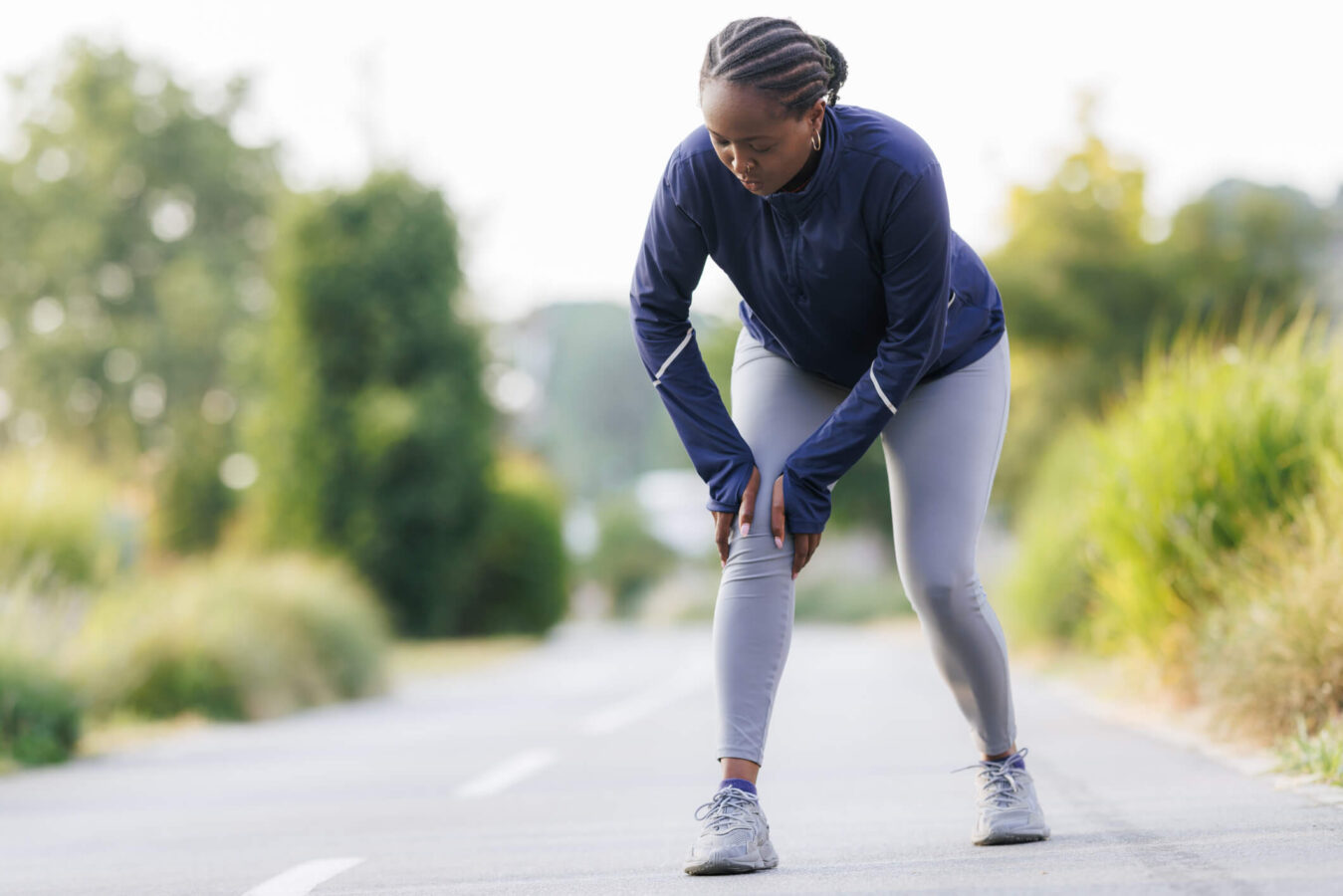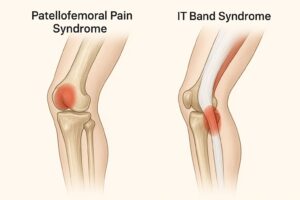
Medically reviewed by Misty Seidenburg
If you’re dealing with persistent knee pain, you’re not alone. Active individuals, particularly runners and cyclists, often experience pain around or outside the knee that can impede daily movement and training. Two of the most common causes? Patellofemoral pain syndrome (PFPS) and IT band syndrome (ITBS). While the symptoms of these conditions can seem similar, their causes and treatments differ. Getting the correct diagnosis matters because what works for one may not help the other. In this guide, we compare the conditions, help you recognize key signs, and explore how knee pain physical therapy and home strategies like IT band stretches or knee strengthening exercises can support your recovery.
PFPS, also known as “runner’s knee,” is one of the most common causes of pain at the front and center of the knee. It usually occurs when the kneecap (patella) doesn’t move smoothly in its groove on the thighbone during activities like running, squatting, or climbing stairs. With PFPS, you might notice:
PFPS often results from muscle imbalances, overuse, or abnormal biomechanics, particularly involving the hip and thigh.
IT band syndrome affects the outside of the knee, where the thick fibrous tissue (iliotibial band) that runs along the outside of the thigh rubs against the thigh bone. This friction leads to inflammation and pain. Common signs of ITBS include:
Unlike PFPS, ITBS is more directly linked to an irritated IT band, poor form, and training on hard or uneven training surfaces.

Not sure which one you’re dealing with? Here’s a quick comparison:
| Symptom or Factor | Patellofemoral Pain Syndrome | IT Band Syndrome |
| Pain Location | Front and inside of the knee, under the kneecap | Outer edge of the knee |
| Pain Type | Dull, aching, possibly grinding | Sharp, burning, localized |
| Trigger Activities | Squatting, stairs, prolonged sitting | Running (esp. downhill), cycling |
| Common Causes | Muscle imbalances at the hip, stiffness at the ankle, poor tracking | Tensioned IT band, weak hips, overtraining |
| Most Affected Athletes | Runners, young athletes | Long-distance runners, cyclists, and hikers |
It’s easy to assume all knee pain is the same, but treating PFPS with strategies meant for ITBS (or vice versa) could lead to frustration and delays in recovery. For example, PFPS often requires a focus on knee strengthening exercises for the quadriceps and glutes. However, ITBS usually improves with IT band syndrome treatment aimed at releasing tension and improving hip control. If you’re unsure which condition you’re experiencing, a physical therapist can perform targeted assessments to help clarify the cause and guide you down the right treatment path.
Both PFPS and ITBS typically respond well to conservative care. Here’s how knee pain physical therapy can support each condition.
For someone with PFPS, the goal is to improve alignment and load tolerance at the kneecap. Treatment often includes:
Many people also benefit from orthotics or footwear changes, especially if flat feet or overpronation are contributing to poor knee alignment. Trust your physical therapist to create a plan tailored to your individual needs and goals.
ITBS is best managed by reducing irritation and addressing the underlying tightness and instability. Effective strategies include:
Many runners notice gradual improvement within a few weeks of focused IT band syndrome treatment, especially when combined with form retraining.
Occasional soreness is normal, but persistent or worsening pain isn’t something to push through. If you’ve tried basic rest, stretching, or exercise modifications and still struggle with symptoms, it might be time to consult a physical therapist. A physical therapist can improve your symptoms and mobility by:
Whether your issue is patellofemoral pain syndrome or IT band syndrome, early intervention can support faster, safer healing.
Once symptoms begin to subside, it’s important to build resilience so they don’t return. Consider incorporating the following habits into your weekly routine to help prevent future knee pain.
By staying consistent with these habits, you’re not just reducing the risk of reinjury. You’re actively building a more resilient and balanced body. Small adjustments today can make a big difference in how your knees feel tomorrow, and beyond.
Knee pain can be discouraging, especially when it interrupts your activity routine. But understanding what’s causing your discomfort is a powerful step toward feeling better. By exploring physical therapy options for knee pain, adhering to a consistent treatment program, and adjusting your training patterns, you can take confident steps toward recovery and return to the activities you love. Find a physical therapy clinic near you to schedule a screening for knee strain today.
Sharp or burning pain on the outside of the knee, especially during running or cycling, often paired with tightness or tenderness along the outer thigh.
PT focuses on reducing inflammation, improving hip and glute strength, increasing flexibility, and correcting movement patterns.
Often caused by poor alignment, overuse, muscle imbalances, or improper footwear, leading to pain around or behind the kneecap during activity.
Physical therapy includes targeted exercises to strengthen the quadriceps and glutes, improve knee tracking, and reduce joint strain.


